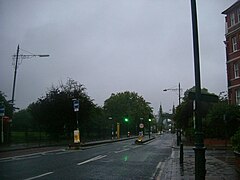Castelnau is a road in Barnes, in the London Borough of Richmond upon Thames, south west London, approximately 5.1 miles (8.2 km) west from Charing Cross on the south side of the River Thames. About 1.1 miles (1.8 km) long, it is the main road south from Hammersmith Bridge and forms part of the A306 road. It was originally named Upper Bridge Road.[1] The name Castelnau is also used informally for Castelnau Estate and the area surrounding the road. It joins Church Road at is southern end, which then runs westwards beside Barnes Green until it meets Barnes High Street.
An area of Barnes including Castelnau was designated a conservation area in 1977.[2]
Etymology edit
Castelnau takes its name from Castelnau-Valence, near Nîmes in France: in 1691, the 10th Baron of Castelnau and St Croix, a Huguenot, fled France for England following persecution, [citation needed] and his son, Charles Boileau, settled in north Barnes and his descendants developed parts of the area. Maurice Boileau, the other son of the 10th Baron, stayed in the Castle and his descendants still live in the castle.
Castelnau means "new castle" in the Occitan language.[citation needed]
History edit
Castelnau was developed after the opening of Hammersmith Bridge in 1827.[3]
Major Charles Lestock Boileau built Castelnau Villas (now 84–122 and 91–125 Castelnau), designed by the architect William Laxton,[3] in 1842, followed by rows of cottages called Castelnau Row, Castelnau Place and Gothic Cottages. After his death in 1889, Upper Bridge Road was renamed Castelnau.[1]
Castelnau Estate edit
| Estate name | Area | No of dwellings | Population 1938 | Population density |
|---|---|---|---|---|
| Pre-1914 | ||||
| Norbury | 11 | 218 | 867 | 19.8 per acre (49/ha) |
| Old Oak | 32 | 736 | 3519 | 23 per acre (57/ha) |
| Totterdown Fields | 39 | 1262 | — | 32.4 per acre (80/ha) |
| Tower Gardens White Hart Lane |
98 | 783 | 5936 | 8 per acre (20/ha) |
| 1919–1923 | ||||
| Becontree | 2770 | 25769[a] | 115652 | 9.3 per acre (23/ha) |
| Bellingham | 252 | 2673 | 12004 | 10.6 per acre (26/ha) |
| Castelnau | 51 | 644 | 2851 | 12.6 per acre (31/ha) |
| Dover House Estate Roehampton Estate |
147 | 1212 | 5383 | 8.2 per acre (20/ha) |
| 1924–1933 | ||||
| Downham | 600 | 7096 | 30032 | 11.8 per acre (29/ha) |
| Mottingham | 202 | 2337 | 9009 | 11.6 per acre (29/ha) |
| St Helier | 825 | 9068 | 39877 | 11 per acre (27/ha) |
| Watling | 386 | 4034 | 19110 | 10.5 per acre (26/ha) |
| Wormholt | 68 | 783 | 4078 | 11.5 per acre (28/ha) |
| 1934–1939 | ||||
| Chingford[b] | 217 | 1540 | — | 7.1 per acre (18/ha) |
| Hanwell (Ealing) | 140 | 1587 | 6732 | 11.3 per acre (28/ha) |
| Headstone Lane | 142 | n.a | 5000 | |
| Kenmore Park | 58 | 654 | 2078 | 11.3 per acre (28/ha) |
| Thornhill (Royal Borough of Greenwich) |
21 | 380 | 1598 | 18.1 per acre (45/ha) |
| Whitefoot Lane (Downham) | 49 | n.a | n.a. | |
|
Source:
| ||||
In 1926, London County Council built a cottage estate of 640 houses, called Castelnau Estate, on the site of a market garden.[4] In 1971 these passed to ownership of Richmond upon Thames Council. Many are now privately owned. Many of the roads in this estate are named after Deans of St. Paul's who had been Lords of the manor of Barnes between the 14th and 17th centuries: Everdon, Kilmington, Alderbury, Kentwode, Howsman and Stillingfleet.[1]
Notable buildings edit
Castelnau is noted for 20 pairs of exceptional classical villas, 91-125 Castelnau, which were built in 1842 by Major Boileau (see above) and are Grade II listed.[5]
There are also two churches:
From around the time of World War II to 1987, the art dealership Abbott and Holder operated a gallery in the house at 73 Castelnau, which was also the home of the founder, Robert Abbott.[6]
References edit
- ^ a b c The History of Castelnau, Holy Trinity Barnes, 1968
- ^ "Castelnau Conservation Area" (PDF). Archived from the original (PDF) on 8 June 2011. Retrieved 20 May 2010.
- ^ a b Bridget Cherry and Nikolaus Pevsner (1983). The Buildings of England – London 2: South. London: Penguin Books. p. 470. ISBN 0-14-0710-47-7.
- ^ Maisie Brown: Barnes and Mortlake Past with East Sheen, Historical Publications Ltd, ISBN 0948667 46X
- ^ "91-125 Castelnau". British Listed Buildings. Retrieved 27 February 2024.
- ^ "History of art in Barnes". Barnes Artists. Retrieved 8 February 2019.

